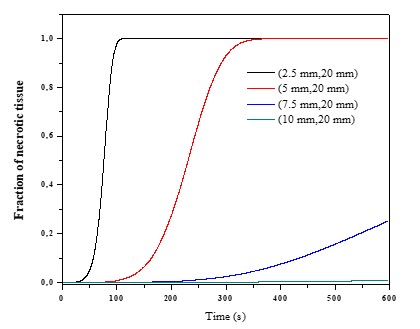



Authors
- Marwa Selmi
- Ahmed Mansour Almansour
- Yousif Mohamed Y. Abdallah
- Hafedh Belmabrouk
Institution
- -Dept of Radiological Sci & Medical Imaging,College of Applied Medical Sciences, Majmaah University
- -Dept of Physics, College of Science Al-Zulfi, Majmaah University
- -Lab of Electronics and Microelectronics, Faculty of Sciences of Monastir, Monastir University
Thermal ablation has recently become a novel technique to kill cancer cells in the liver, kidney, bone, lung, and other organs. This technique is widely used to treat tumors that are difficult to treat surgically. The ablative treatment family involves the microwave ablation (MWA), the radiofrequency ablation (RFA), and ethanol ablation. These ablation methods use the heat transfer to treat and kill cancer cells. RFA has been developed and used in the clinical treatment in USA while the MWA is still a current research topic and reveals ongoing improvement. Computer simulation proves to be necessary in the phase of the design and optimization of novel devices, and it is a useful tool for exploring and planning treatment strategies. In order to assess the feasibility of using the computational models of MWA to tissue biophysical properties, an electromagnetic model and bio-heat equation are coupled and computed with the finite element method (FEM). A micro-microwave coaxial antenna (MCA) is inserted into the biological tissue. It can emit an energy that creates heat in the tissue. The heat will be distributed around the surrounding tissue. In this work, we focused to study numerically the temperature distribution profile, the specific absorption rate (SAR) and the fraction of the necrotic tissue to treat breast cancer. The results show that the SAR is higher in the case of single slot antenna than those of dual slot antenna. The SAR is reduced by 17% using the dual slot antenna.
Keywords: Numerical simulation, breast cancer, microwave ablation, electromagnetic heating.
The microwave ablation is produced by the electromagnetic radiation field emitted from an antenna inserted into the tissue. The radiation emitted by the antenna is absorbed by the tissue and leads to heat cancer cells and their surroundings.
- The Specific absorption rate (SAR) -defined as the ratio of absorbed heat power and tissue density- take the following expression:
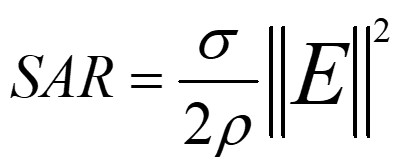
-The distribution of the temperature inside the tissue breast is obtained by solving the bio-heat equation:

Where ρ is the density of the tissue (Kg/m3), C is the is the specific heat capacity of the tissue (J/kg.K), k is the thermal conductivity of the tissue (W/m.K), ρb is the blood density (Kg/m3), Cb denotes the specific heat capacity of the blood (J/kg.K), ωb represents the blood perfusion rate (1/s), Tb is the blood temperature (K), Qmet represents the heat source from metabolism, Qext is the external heat source, both measured in (w/m3).
- The fraction of tissue necrosis is calculated from the expression:
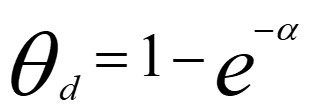
where θd represents the induced thermal damage and it is computed using the Arrthenius equation:

where 𝐴 is the frequency factor (1/s), 𝐸𝑎 presents the activation energy (J/mol), 𝑅 is the gas constant and 𝑇 is the temperature.
The model geometry used in this simulation is shown in Figure 1. It consists of an antenna immersed in biological tissue. Especially, the antenna is formed by an inner conductor, a dielectric, and an outer conductor containing a ring-shaped slot with height 1 mm. A plastic catheter surrounds the antenna. The antenna operates with frequency (2.45 GHz).
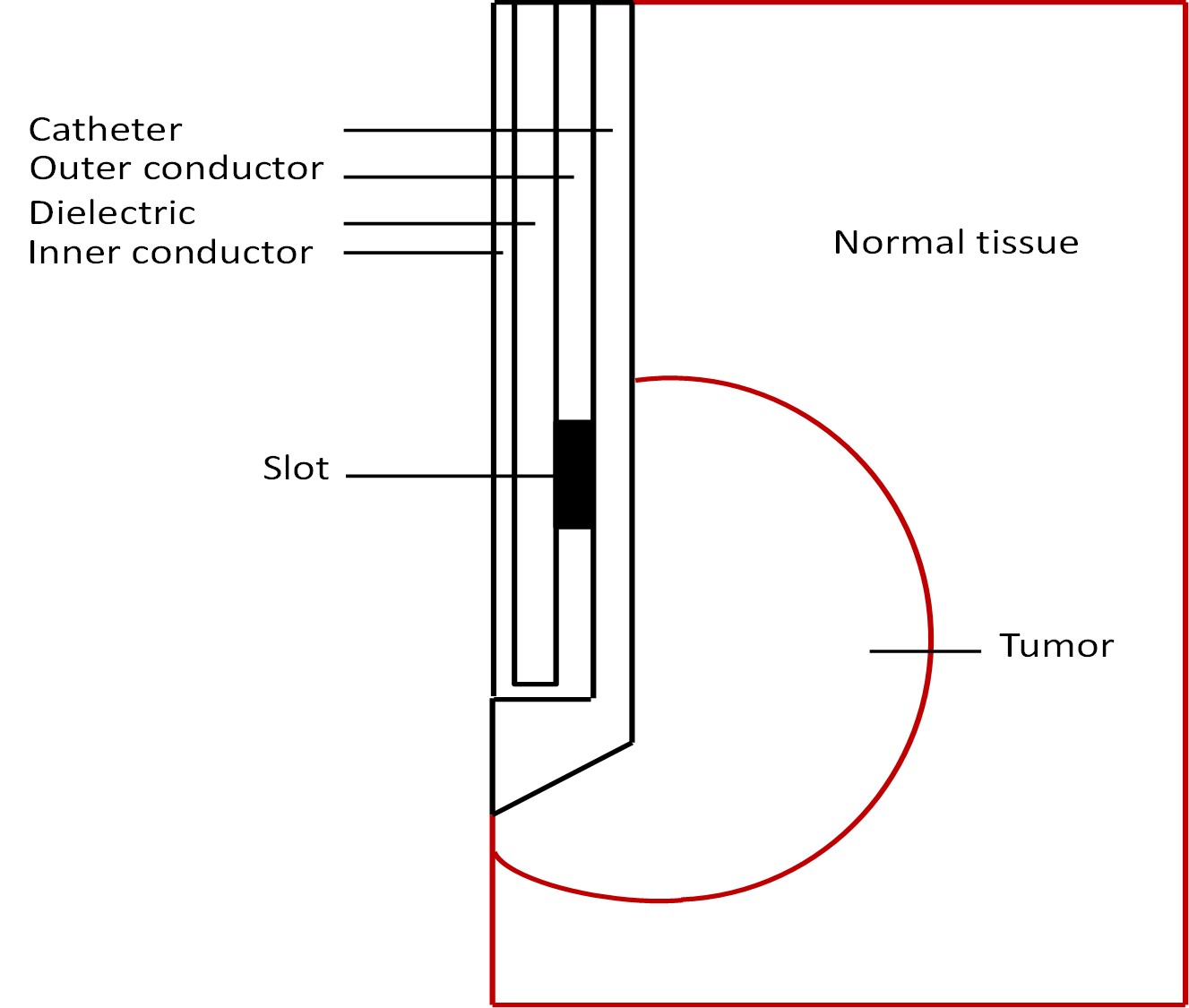
Fig 1: The geometrical model for the microwave ablation system.
This work presents a numerical study of heat transfer coupled with electromagnetic wave propagation in breast tissue during MWA process using a single and double slot MCA. An electromagnetic model coupled with bio-heat equation are computed with the finite element method (FEM). In this study, single and double slot MCA are used for the tumor heating in order to estimate their effects on the temperature distribution, the specific absorption rate (SAR), and the fraction of the necrotic tissue to treat breast cancer. As a result, we find that the number of the slot in the antenna system strongly influence the temperature and SAR distribution. The highest temperature and the maximum SAR are appeared in the case when using the antenna with single slot than when using double slot.
[1] Sundeep Singh, Ramjee Repaka. Quantification of Thermal Injury to the Healthy Tissue Due to Imperfect Electrode Placements During Radiofrequency Ablation of Breast Tumor. Journal of Engineering and Science in Medical Diagnostics and Therapy, (2017), Vol. 1 / 011002-10.
[2] Heba Abdelhamid Elkayal , Nour Eldin Ismail, Mona Lotfy. Microwaves for breast cancer treatments. Alexandria Engineering Journal (2015) 54, 1105– 1113.
[3] Mario Francisco Jesus Cepeda Rubio, · Geshel David Guerrero López, Francisco Valdés Perezgasga,· Francisco Flores García, Arturo Vera Hernández,· Lorenzo Leija Salas. Computer Modeling for Microwave Ablation in Breast Cancer Using a Coaxial Slot Antenna. Int J Thermophys (2015) 36:2687–2704.
[4] Jason Chiang, Peng Wang, Christopher L. Brace. Computational Modelling of Microwave Tumour Ablations. Int J Hyperthermia. 2013 June ; 29(4): 3 08–317.
[5] Sundeep Singh, Arka Bhowmik, Ramjee Repaka. Thermal analysis of induced damage to the healthy cell during RFA of breast tumor. Journal of Thermal Biology 58(2016)80–90
The numerical results presented in this work are computed based on a frequency of 2.45 GHz and microwave power of 10 W. Fig.2 shows the SAR distribution for the single and double slot antennas along a line parallel to the antenna and at a distance of 2.5 mm from the antenna axis. The result indicate that the SAR is higher in the case of single slot MCA than that of the double slot MCA, which can be attributed to a higher microwave power absorbed by the tissue.
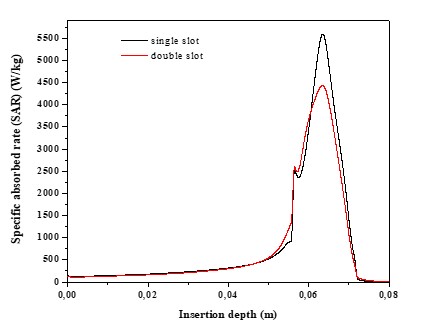
Fig. 2: SAR profil in the two cases of using single slot MCA and double slot MCA along a line parallel to the antenna and at a distance 2.5 mm.
The MCA principle is to apply microwave power to the breast tissue through the MCA. The radiation emitted by the antenna is absorbed by the tissue and leads to heat cancer cells and kill them. Fig. 3 (a) and (b) illustrate the simulated temperature curves for four position in the breast in the case of single slot MCA and in the case of double slot MCA respectively. In the both cases, the temperature increases with increasing time and decreases with the distance. As a comparison, at the position of 2.5 mm from the antenna, the temperature of single slot MCA is higher than that case of double slot MCA, while at the position of 5 mm, 7.5 mm and 10 mm, the result show similar trends of the temperature
(a)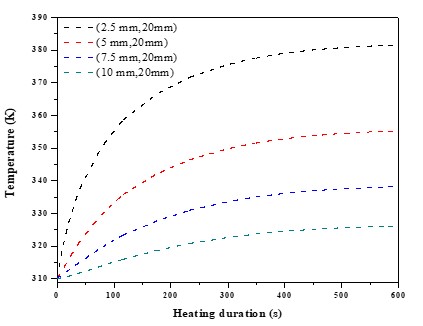 |
(b) |
Fig. 3: Temperature curves at four position using single slot MCA (a) and double slot MCA (b).
Fig.4 (a) and (b) present the fraction of necrotic tissue at four different point of the breast tissue in the case of single slot MCA and the case using double slot MCA as function of the ablation duration. The results of both cases show similar trends of the fraction of necrotic tissue. In both cases, the fraction of necrotic happens faster at the antenna zone.
|
(a)
|
(b)
|
Fig.4: Fraction of necrotic tissue at four points of the breast in the single slot MCA (a) and double slot MCA (b)
The authors extend their appreciation to the Deanship of Scientific Research at Majmaah University for supporting this work



